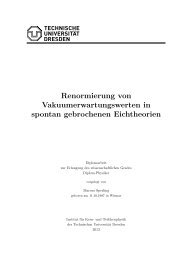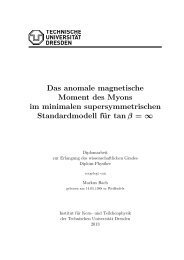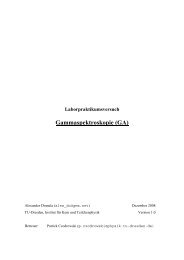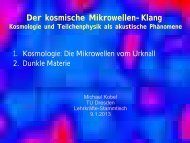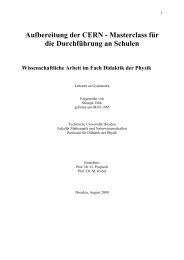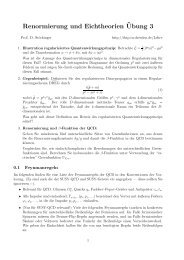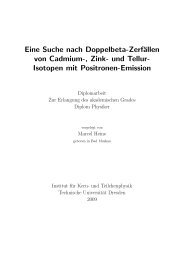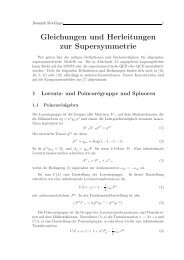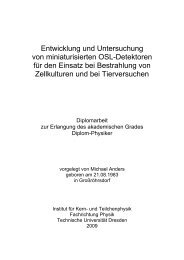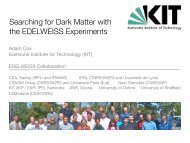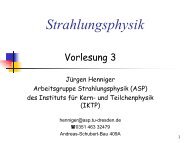A Mathematica based Version of the CKMfitter Package
A Mathematica based Version of the CKMfitter Package
A Mathematica based Version of the CKMfitter Package
You also want an ePaper? Increase the reach of your titles
YUMPU automatically turns print PDFs into web optimized ePapers that Google loves.
24 Chapter 4. A <strong>Ma<strong>the</strong>matica</strong> <strong>based</strong> <strong>Version</strong> <strong>of</strong> <strong>the</strong> <strong>CKMfitter</strong> <strong>Package</strong><br />
4.5.4 DecayBagParameters<br />
The <strong>Ma<strong>the</strong>matica</strong> <strong>based</strong> version <strong>of</strong> <strong>CKMfitter</strong> avoids <strong>the</strong> usage <strong>of</strong> global variables.<br />
However, <strong>the</strong>re are some model parameters, e. g. <strong>the</strong> decay constants and bag parameters<br />
<strong>of</strong> Bd- and Bs-mesons:<br />
fBs ,<br />
fBs<br />
fBd<br />
, Bs , Bs<br />
Bd<br />
, (4.4)<br />
which are used in different <strong>the</strong>ory packages. Thus, <strong>the</strong>y need to be “globalized”,<br />
through initializing <strong>the</strong>m in a separate package, which will be sourced from <strong>the</strong> o<strong>the</strong>r<br />
<strong>the</strong>ory packages. The DecayBagParameters package is currently loaded from <strong>the</strong><br />
BBbarKKbarMixing package as well as from <strong>the</strong> LeptonicDecay package.<br />
4.6 Look-Up Tables<br />
Since <strong>the</strong>re is not always <strong>the</strong> possibility to express a measurement in terms <strong>of</strong> a value<br />
and an error, <strong>the</strong> experimental likelihood, translated into a χ 2 -contour, can also be<br />
used as an input. It is available in a discrete look-up table, where values in-between<br />
<strong>the</strong> discrete LUT entries are calculated through interpolation. The <strong>Ma<strong>the</strong>matica</strong><br />
<strong>based</strong> <strong>CKMfitter</strong> version provides <strong>the</strong> possibility <strong>of</strong> a cubic spline interpolation and<br />
uses a separate FORTRAN <strong>based</strong> function to load <strong>the</strong> LUTs during <strong>the</strong> fit.<br />
4.6.1 Cubic Spline Interpolation<br />
Piecewise interpolation using low order polynomials leads to a global continuous<br />
interpolating function, but is in general not continuous at <strong>the</strong> interval boundaries.<br />
This is avoided by using cubic spline interpolation, which gives back a smooth interpolating<br />
function. The goal <strong>of</strong> cubic spline interpolation is to get an interpolation<br />
formula that is smooth in <strong>the</strong> first, and continuous in <strong>the</strong> second derivative, both<br />
within an interval and at its boundaries.<br />
A cubic spline interpolation function s(x) to <strong>the</strong> sampling points x0 < x1 < . . . <<br />
xn−1 < xn and <strong>the</strong> corresponding sampling values yj (j = 0, 1, 2, . . . , n) is defined<br />
by [25]:<br />
• s (xj) = yj for (j = 0, 1, . . . , n);<br />
• s (x) is for x ∈ [xi, xi+1] (i = 0, . . . , n − 1) a polynomial <strong>of</strong> at most <strong>of</strong> order 3;<br />
• s (x) ∈ C 2 ([x0, xn]);<br />
• s ′′ (x0) = s ′′ (xn) = 0.



